
|
Published
by CTC Press
Seattle,
WA 98103
Copyright
(c) 1990 by C.T. Chew
Library
of Congress cataloging in Publication Data Main entry under title:Ralph
Doid city planner
1.
English language--biography FBI567.CS 34T3 76-35WISBN 0- 38658932 Undexed)
ISBN 0- 91870915 deluxe
Doid
is a registered trademark of the Duwamish historical Society.All rights
reserved. No part of this work covered by the copyrights hereon may be
reproduced or copied in any form or by any means (except photocopy or over
the Web of course) without written permission of the publisher.
Made
in the United States of America
120790 |
Contents:
Dedication
[ii]
Preface
[ivl
Ralph
Doid, a Man and Some Dreams [1]
The
Centennial Celebration Banner [4]
The
Oriental Obelisk [5]
Psychotherapy
[7]
Floating
City Hall [10]
Architecture
[12]
The
Great Wall of Seattle [13]
Appendix
I
- About the Artist and Author [15]
II
- Catalog of Restorations [16]
III
- Making of the Banner [17]
Choice
of Coffee, Tea, or Aperitif
with
your Dessert
[iii]
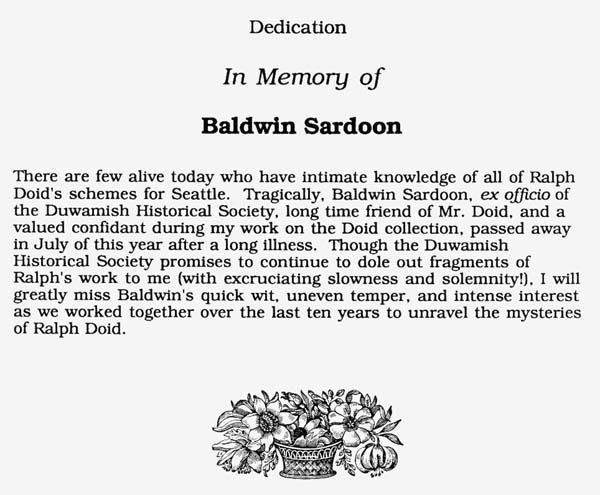 Preface
Preface
The
history of Seattle is salt and peppered with the lives of interesting characters.
From the pioneers who tried in vain to locate Seattle on the Alki sand
spit before finally retreating to the shelter afforded by Elliott Bay,
to R.H. Thompson who removed the dirt from Mr. Denny's hill to a mile south
so we can enjoy the Kingdome today, colorful individuals have left their
indelible marks on our present condition. None of this legacy of movers
and shakers received such an acclaim of mixed reviews though, as did one-
the wiry, bespectacled, enigmatic Ralph Doid.
In
1979, having lived in Seattle for a modest 10 years, I had not yet had
the pleasure of a postmortem introduction to Ralph Doid (he died in 1956).
But an article in the Seattle Times (Fig.-1) that year caught my attention.
 |
It
was not long after clipping this news item out and pinning it to my wall
that I became intrigued with restoring some of Mr. Doid's drawings and
ideas. I wrote to the Duwamish Historical Society and was referred to its
president, Baldwin Sardoon. Using examples of my artwork, I convinced Mr.
Sardine that I should be trusted to work on the Doid documents damaged
in the fire. Later, I received a letter from the Society trustees who gave
me permission to begin work, but cautioned me that they had no funding
for the project and thought I should find a source of remuneration for
the extensive work which the restoration would require. |
Concurrently,
the City of Seattle through its Arts Commission was seeking proposals from
the community for artwork which was thoughtful in its contemplation of
the "city as museum". A small flame of hope ignited within me as
I used my imagination to stretch the Arts Commission's prospectus for funding
into my ticket to recreate Ralph Doid's work.
Luckily,
I received the Doid grant, and my work began. Today, ten years and many
restorations later, it still continues! Due to the generous support of
the City of Seattle, Russel Barsh, and Doris and Martin Haykin of the Duwamish
Historical Society, the Mertleman Benz Foundation, and now Bryan Schiffrin
McMonagle Elston & Twiss I
have been able to further our understanding and enjoyment of someone, who
in the eyes of many, is the vital pith of our northwest roots.
Ralph
Doid, a Man and Some Dreams
Reference
to Ralph's parents is sketchy. We do know that they traveled by train from
Philadelphia to the Northwest in 1881, setting up a small family store
which quickly evolved into what could only be described as a 'ma and pa'
pharmaceutical company. Both Franklin and Edith Roth Doid prided themselves
in their concoctions for "every ailment that can get'cha", and tested each
new drug on themselves, believing that tests on animals or other humans
were "beside the point". This testing during Edith's pregnancy probably
resulted in a syndrom. that Seattle historian Milton Lavery calls, "a Helenic
tragedy shadowing Ralph's entire life."
It
comes as no surprise that young Ralph was a difficult son and impossible
student. His parents and teachers, concerned over a wild imagination connected
to a hyperactive physique, requested his admission to the Foremost Correctional
and Mechanical School in Fairmont, Kansas, in 1899.
"It
is one thing for children to dream," wrote his father, "but Ralph constantly
brings his dreams into reality, using talent and skills neither we nor
his teachers can claim to have given him. Though he is not yet 10 years
old he has performed such 'miracles' as diverting the stream behind our
house into our basement so as to have an indoor swimming pool! Is there
a place at Foremost for such a lad?"
There
was. And in 1907, the year of his graduation, Ralph became its valedictorian.
From
there he entered the Boulder Architectural and Engineering Home, receiving
his certification with honors in just under six years, a record for the
institution which had a fairly difficult eight year program.
Degree
and recommendations from professors in hand, Ralph returned to the place
of his destiny, Seattle, in 1913, and immediately obtained a position on
the city's survey crew.(Fig.-2)
 Fig.-2
Fig.-2
|
From
his diary we know he was
determined
to repair the trust he had lost
many
years before and create a new order:
"...
that would elevate opinion of myself and Seattle as if it were ascended
to the golden gates of Heaven itself Yes, golden gates. Now that's a good
ideal Wonder where we could put them?..."
Using
the "Golden" Gates theme
he
proposed
a strategy for the city's development which he presented to the Engineering
and Planning Department in the spring of 1915. It seems he never received
a reply. Was it because they didn't take him seriously, or as he claimed
many years later,
"Walter
Stanweed, who was the Assistant City Engineer, and to whom I had addressed
my letter with plans for the Golden Gates, mysteriously left the city's
employment and soon thereafter turned up in San Francisco. Then,
how long was it, a year or two maybe, before we heard the news—San Francisco
would build a bridge and call it the Golden Gate! He stole that idea
from me, and there was not a dad blamed thing I could do about it!
Why, whoever heard of a bridge called a gate, anyway!"
|
Though
his Golden Gates initiative failed, within two years Ralph had worked
his way into a position on the City Planning Commission through normal
channels. Here, among the ranks of Albert Landis, famous for putting the
"Green" in Greenlake, and Miriam Flattery who invented asphalt paving for
the city in 1932, Ralph's legacy of theoretical thought blossomed.
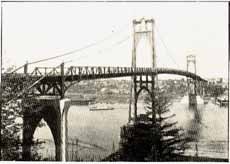 Fig.-3
The Golden Gate Bridge. Could it have been Seattle's?
Fig.-3
The Golden Gate Bridge. Could it have been Seattle's?

The
Centennial Celebration Banner
There
are five works represented on the Centennial Celebration Banner. Chronologically
they are: The Oriental Obelisk (4); Ralph's Innovations in Psychotherapy
(3); his plans for a Floating City Hall (1) & (2); the self
designed Architecture of his House (5); and perhaps his masterwork,
the Great Wall of Seattle (6) & (7).
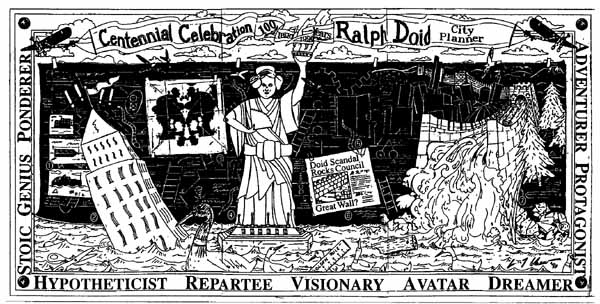
(4)
The Oriental Obelisk
In
1928 Ralph traveled to New York City, to represent the Seattle Redmen Lodge
#345 at their national convention. In his journal he writes,
"The
majesty of the Statute [sic] of Liberty leaves me in a breathless state.
Oh, how could we on the west coast survive yet one more minute without
a counterpart to her beauty and inspirationl"
It
was here that the idea of his Oriental Obelisk took shape. She was
to be a Japanese woman, dressed in a kimono, holding a fan in one hand
and a solar powered, steaming rice bowl in the other. She would stand somewhere
out in Elliott Bay, welcoming visitors and immigrants.
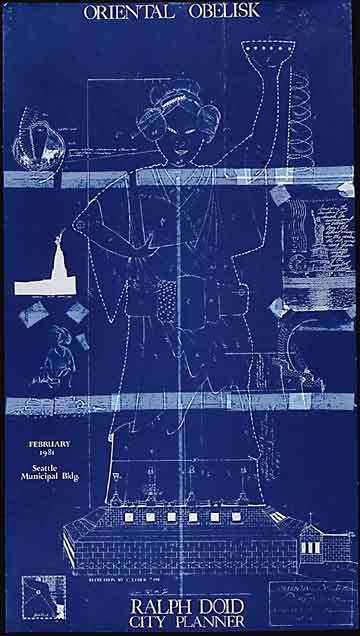
|
His
idea was ill received by the City Council though. According to record,
he was informed that the water in the bay was exceedingly deep and asked
how or on what the Obelisk would be built. Ralph answered cooly that just
as with the earlier Denny Regrade project, the City should consider a Queen
Anne regrade with the dirt going to create an artificial island for the
Obelisk.
It
is to Mr. Doid's credit that although the Obelisk was never approved,
his vision of the future was exceptionally keen (as we shall see time and
again). Today we look with great enthusiasm to the Orient, |
especially
Japan, for partnerships in business and technology, and consumer products.
In addition, his explorations into solar power predate our own need for
this resource by 60 years!
(3)
Psychotherapy
Like
Kafka, Jung, Schlantmeister, and Freud, Doid was captive to a mind of incomprehensible
psychological inquest. If we are to believe the record of letters left
behind, Ralph corresponded freely and inventively with other great minds.
Below, a letter dated February 23, 1930 from Sigmund Freud to Doid, is
a case in point.(Fig.-4)
-
February
23, 1930
-
My Dear
and Great Friend Doid,
-
Many thanks
for your letter, and my apologies for a tardy reply. Alas, duties here
at my Vienna Institute keep me from the fast break correspondence which
I relish.
-
I guess
I could ramble on and on about my current psychoanalytical work with the
ego, the uh ok and the no no, which I know would interest
you greatly, but I am really more fascinated in discussing that innovation
you forwarded to me in your last letter- that inkblotch! (Fig.-5)
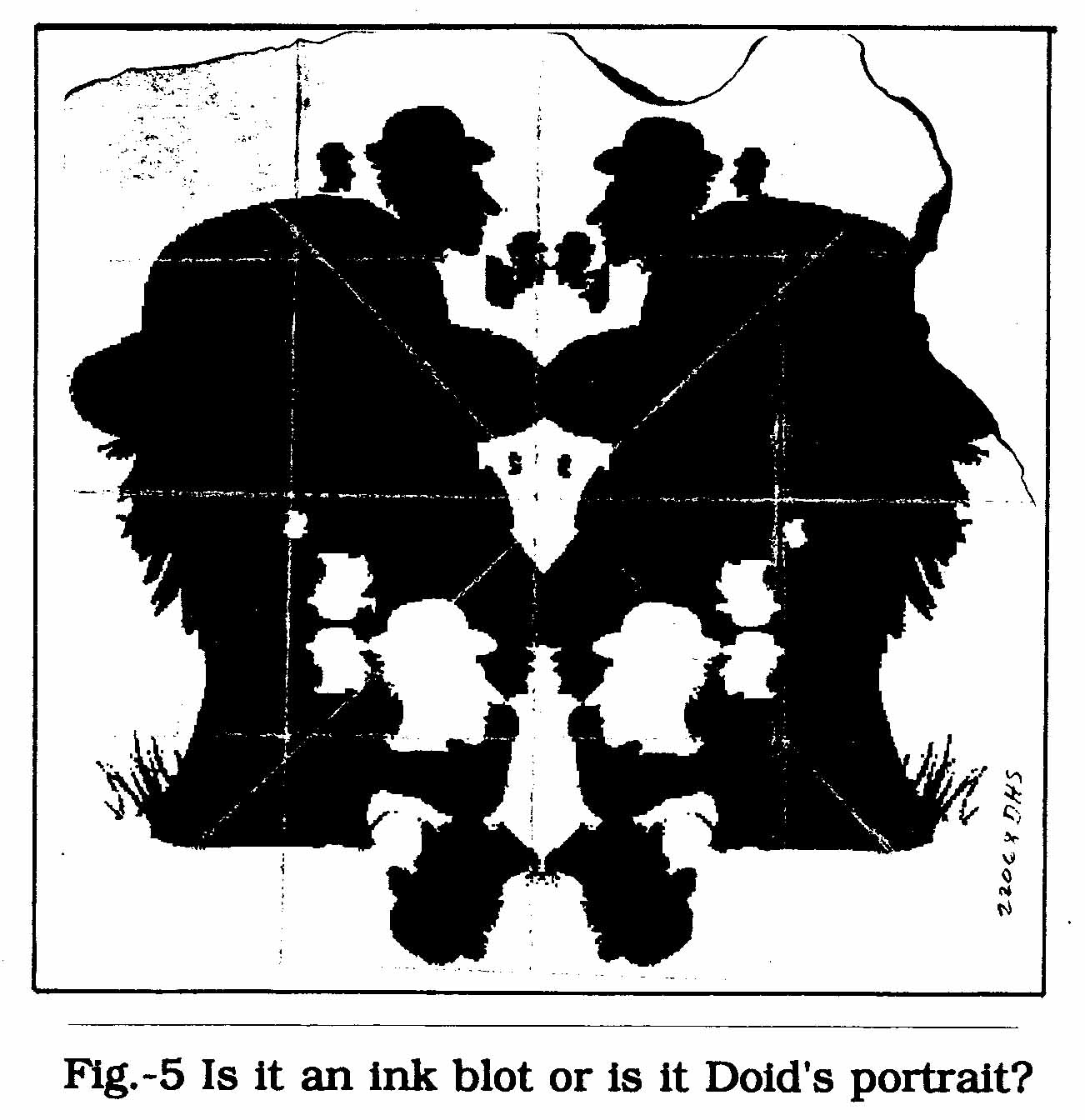
|
Your
idea that it might act as a 'canal' into the unknown regions of the psyche
is positively genius! Why, I stared at that thing for hours, seeing a machination
of faces, no, heads, intent on disturbing the ego underpinnings of Saturnalia.
I realized then that I was more in need of analysis than I ever, ever suspected!
In future years I predict your, what shall we call it, Doid Ink Blot
Test (?) will allow psychiatrists and therapists to schedule many extra
thousands of visits with their patients! |
-
I would
like to recommend you to my regents as a paid guest speaker at one of our
future conferences, perhaps a CME on Maui, in January of next year? Id
be fun, don't you think?
-
Yours
sincerely,
-
Sigmund
Freud
-
PS...
better try to obtain a patent!
-
Translation by Karl
Buechmann
(1)
& (2) The Floating City Hall
If
one were to describe Ralph Doid's career on the Planning Commission in
a single word, that word would be frustration. By 1940 Ralph had
been at work for 25 years, but he still couldn't point to a single idea
which had been approved by the city. Out of this frustration grew his design
for a floating city hall. Though never intended for actual construction,
Ralph joked.
"...how
convenient it would be to get them all into one big boat and give them
a good pushl"
The
templates are from a series which he designed outlining 'famous floating
buildings' around the world. Later he confided in his colleagues that he
was having a difficult time deciding whether the new city hall should float
on its side or bob up and down (also see Doid's
Dilemma).
This
and other schemes were emblazoned in a song of the time, popular with school
children and their parents alike. Ask someone who attended elementary school
in Seattle in the 40's and they'll most likely remember it. This is Baldwin
Sardoon's version:
Da
da da da
Ralph
Doid,
what
did you do?
Da
da da da
Oh
no,
what
did you do? (Chorus)
Tired
feet, you get your wish,
To
ride downtown in a fish.
Underground.
out of the rain,
But
some people say he is a scatterbrain.*
(Chorus)
Do
you remember Queen Anne Hill?
And
what they did with the regrade fill?
If
you don't, tisk, tisk, tisk,
It's
the Oriental Obeliskl
(Chorus)
Look
out in the bay,
City
Hall just floated away.
I
don't know when well get it back,
I
guess Ralph Doid is just a quack.
Da
da da da..etc.
* This
verse refers to the underground trolly proposed by Doid. If he were only
alive to see the new Metro Tunnel completed in 19901
(5)
Architecture
Look
past the major elements on the banner to the blue and white background.
This is a representation of the actual critical path management chart
prepared by the Coroner's Office following Mr. Doid's demise in 1956.
Ralph
took great pride in the fact that he had designed his personal residence.
Completely without artistic distinction, the house nevertheless contained
one interesting feature, an exterior door on the second floor without adjoining
stairs. Neighbors joked that it was Ralph's "door to nowhere". But on May
25th, 1956, sometime during the night, it became a door to somewhere for
Doid. His body was found the following morning beneath the unfortunate
architectural feature.
 The management
chart was prepared to determine how construction was allowed to proceed
without proper city inspection and adherence to the building codes. It
wasn't the only time that Ralph Doid had snuck around the city bureaucrats!
The
Great Wall of Seattle
The management
chart was prepared to determine how construction was allowed to proceed
without proper city inspection and adherence to the building codes. It
wasn't the only time that Ralph Doid had snuck around the city bureaucrats!
The
Great Wall of Seattle
Strange
and weird things began to happen around what is now the Tukwila/1-5 exit
in the spring of 1948. Construction was beginning on a project which no
one was quite sure about. Plans were marked TOP
SECRET. Contractors
were threatened to remain silent. Fences and barricades were erected blocking
boulevards and streets. Millions of tons of stone were dumped on lawns
and in parks. Heavy equipment rumbled through neighborhoods in the dead
of night. Houses were condemed and occupants given only days to vacate.
As
horrendous as this seems, it was months before a brave reporter from the
Seattle PI broke the story. "Doid Scandal Rocks Council" read
the headlines. Something that had remained secret for so long swept Seattle
overnight.
Clearly,
a wall, a great wall, was being constructed around the city. But how and
why would one individual forge such a plan? Doid was hauled before the
Council.
(From
the City Councfl transcript, July 16, 1948)
Was
it your idea? Yes.
Did
you use personal staff wittingly or unwittingly to develop the
plans?
No.
The
scheme was entirely yours and yours alone? Yes.
How
did you obtain the permits? Forged the signatures.
And
the Council approval for capital improvement expenditures?
Forged
the signatures.
You
forged our signatures? Yes.
Did
you send the work out for bid? No, no bids. Just handed
out the contracts.
Didn't
anyone think this whole thing seemed a bit-ftshy? No.
No
one? No. Seems people don't think much these days.
Why
did you do it? It's a complicated idea.
Well,
will you try to tell us? I don't think you'll understand.
Tell
us Ralph! Ok, ok! You all know I've worked for the city for 30 years.
Seattle is such a gem. Sometime in the future people will probably think
this is just about the best darn place in the world to live. I've used
my entire career to try to give her a little more character and charm.
But you've stopped me at every turn! All these years I've been trying
to get you to look into a crystal ball, but you guys are just staring into
a fish tankl Know this, there will be an underground trolley in Seattle
someday! There will be an Oriental Obelisk! Don't you want to have those
things here instead of somewhere else? Yes, I tried to build that wall!
I tried because no one in this piece of paradise would listen to me. And
you would have thanked me too. Yes sir, twenty or thirty years from now
when people catch on to what a nifty place this is, they're gonna try to
come here. Millions of 'em! And by gosh, what are you gonna do? How are
you going to keep them out? How are you going to keep real estate prices
down? Keep your air clean and your streets safe to walk? How? The Chinese
knew how, and it worked for them for hundreds of years. They built a wall.
I intended to build one too! I'm sorry I failed.
Ralph
Doid was dismissed from his post as a City Planner. During the subsequent
trial he was brilliantly defended by a young lawyer, J. Robert Rollins,
who later went on to become Govenor of the State of Washington. Their defense
is considered a legal classic, being the first and major precedent for
what we now call the insanity plea. Was it the pharmaceuticals which his
mother tested during her pregnancy? Was it the inability of his parents
to give him a loving and secure childhood? Was it an unknown trauma at
Foremost Correctional and Mechanical School? Or was it simply a radiant
life burning too brightly before its time?
The
Centennial Celebration Banner says it all I think: Ralph Doid ADVENTURER.
PROTAGONIST. DREAMER. AVATAR. VISIONARY. REPARTEE. HYPOTHETICIST. STOIC.
PONDERER. GENIUS!
Thank
you Ralph Doid!
Appendix
I
About
the Artist and Author
C.T.
Chew, master craftsman and romantic visionary, plays with all the masks
of multi-media in his search for an ideal art where all are one. He calls
this concept of an engulfing contemporary school of artistic philosophy
MAMA. Arthur Weissman, writing in Art on Art magazine says:
"Chew
thinks of each of his works as a MaMaism. They result not from one of the
many exclusionary principles which have governed artistic movements throughout
history, but an embracing of all techniques, all media. and all philosophy.
"Ralph
Doid excites him, because without any conscious knowledge of it. Doid was
an early MAMAistl Realistic yet abstract, funny yet intensely serious,
of both mind and body, he typifies a growing international circle of artists
who embrace the motto, "Come to MaMa."
Mr.
Chew has been a resident artist in Seattle for over twenty years. His pieces
are in numerous public and private collections. In 1989 the Seattle Art
Museum exhibited a retrospective covering 15 years of his work as part
of the Documents Northwest series. He and a work about Ralph Doid
are included in the book Fifty Northwest Artists.
Appendix
H
Restorations
"Oriental
Obelisk", Cyanotype, 1981.
The
Floating City Hall", Cyanotype, 1981.
"Ralph
Doid City Planner", Assemblage, Collection of the City of Seattle, 1981.
'The
Obelisk", Mixed media, Collection of Carolyn Law.
'The
Obelisk", Color Xerox Stamps, 1981. "Ralph
Doid, City Planner", Video,
Collaboration with Bill Ritchie, 1982.
"Doid's
Dilemma", Mixed media on paper. Collection of Russel Barsh, 1982.
"Doid's
Dilemma", Mixed media assemblage, Collection of Doris and Martin Haykin,
1982.
"Centennial
Celebration Banner", Woolen Embroidery, Collection of Bryan Schiffrin McMonagle
Elston & Twiss, 1990.